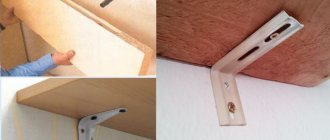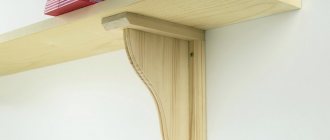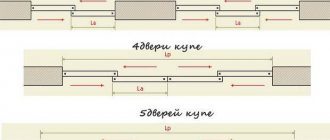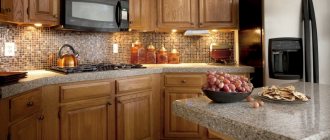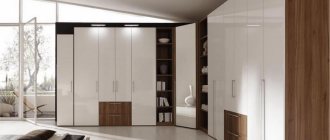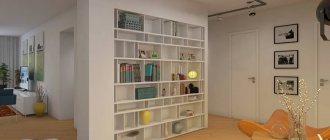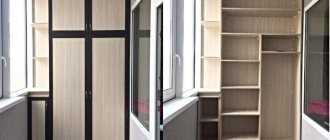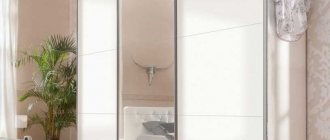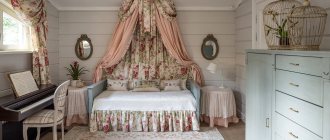Fastening shelves in a closet made of different materials
The majority of cabinets are made of laminated chipboard. A separate group includes models made of solid wood and MDF, as well as built-in cabinets with shelves made of plasterboard, furniture panels, plywood and other sheet materials.
In the future, we will start from the fact that both the body and the shelves of the cabinet are made of the same material - chipboard, MDF, plywood, solid wood with a thickness of 12-20 mm. Here we will consider the remaining, “non-standard” cases.
Fastening glass shelves
Fastening a glass shelf involves drilling the sides of the cabinet for shelf holders of various types. They can be “barrels” in a silicone shell, corners with a suction cup in the simplest version, or varieties of “pelicans” or “toucans” with a girth around the end of the shelf.
If the cabinet body itself is also made of glass, then UV gluing can be used for fastening. Also in the range of accessories for glass shelves you can choose special holders with through fastening. In this case, it is necessary to clarify the diameter of the holes for drilling (as a rule, fasteners are designed for installation in 5 or 8 mm holes).
Fastening mesh shelves
Mounting a metal mesh cabinet shelf is usually included in the kit. The shelf itself is sawn off to fit the internal size of the niche for installation; special holders are installed on the longitudinal rods on each side.
If a hanging rod or a support for inclined mounting is required (if it is a shelf for shoes), then the corresponding accessories are also purchased separately.
The metal shelf can be retractable. The draw-out mechanism is attached to the sides of the cabinet using regular 3x16 or 4x16 self-tapping screws. When installing, we recommend using the installation instructions - depending on the manufacturer, there may be nuances regarding the marking of reference points.
In some wardrobe systems, metal shelves are mounted on the wall, using special supporting rails and cantilever holders.
Built-in wardrobe: attaching shelves to walls
When installing built-in wardrobes, plastic corners of the “commander” type and consoles are usually used.
If the sides of the built-in wardrobe are made in the form of plasterboard partitions and it is not known where the mortgages are located, then it is better to use timber to support the shelves. A point connection will not be very reliable.
If necessary, attach heavy shelves or a mezzanine cabinet to loose walls. The beam will serve as a reliable support.
Features of decorative products
Metal corners that perform a purely decorative function are classified into a separate category. They are made only from iron, as embossing and engraving are used to decorate the surfaces. The main purpose of such products is to decorate open shelves and racks, drawers and chests. There are no additional reinforcements or reinforcements, since the purpose of use is not screed, but finishing.
Decorative fittings can be used simultaneously with regular ones. The main features of the corners used for decoration are their non-standard shape and the presence of a distinct relief, convex or concave pattern on the surface. Sometimes elements are artificially patinated to obtain a greenish color to the metal surface (antique stylization).
Products intended for decorating furniture come in two types depending on the shape:
- classic plate bent at right angles;
- volumetric structure of three faces connected to each other.
The volumetric version of the corner looks more impressive and is often used to design open modular structures.
Experts recommend using decorative corners to design antique-style products. However, such overlays are not suitable for furniture made in modern styles (loft, hi-tech, industrial). It is desirable that the pattern on the metal surface echoes some motif in the interior decoration (for example, a pattern on wallpaper).
Ordinary
Decorative
Through fasteners (with drilling) for confirmations
Confirmats are the most common through fasteners for shelves. To install, you will need to drill a hole in the end of the shelf with a diameter of 5 mm and on the front side of the side of the cabinet with a drill with a diameter of 8 mm. It is better to use a special confirmation drill. Since a countersink is still required for the head, the screw itself is flush with the surface of the sidewall. Next, the cap is hidden with a special self-adhesive plug, matched to the color of the chipboard.
A nuance: depending on the thickness of the sidewalls, the length of the confirmat is selected. For standard chipboard and MDF thicknesses of 16-18 mm, a 5x50 euroscrew is used; for thicker board materials, a longer one is used, up to 70 mm.
- Among the advantages of attaching shelves to confirmations, it is worth highlighting the ease of assembly and the low cost of the fasteners themselves.
- The downside is the need to drill through. Not everyone likes the “holey” sides of the cabinet from an aesthetic point of view. Although the self-adhesive plugs are color-matched, they are still visible. Also furniture assembled through repeated assembly and disassembly.
Materials
Corner fittings are made of metal or plastic. The first option is preferable if the product is designed for heavy loads. The metal has a long service life. Plastic, on the contrary, quickly deforms.
| Material | Characteristic | Scope of application | Advantages | Flaws | Recommendations |
| Metal | Massive product with stiffening ribs. Iron strip bent at right angles | Large cabinet and upholstered furniture | Durability, long service life | Susceptibility to corrosion | If a metal corner is used for mounting garden (country) furniture that will stand outside, it needs preliminary anti-corrosion treatment |
| Plastic | Plate that is attached with self-tapping screws | Small interior items: shelves, stands for shoes and indoor plants | Light weight, easy to use | Plastic parts bend and deform easily | Due to low strength, it is not recommended to use when installing children's furniture |
Technology for the production of oak furniture panels, its pros and cons
The corner is often used when assembling kitchen and wardrobes. This element of fittings is indispensable when installing various headsets. Metal is much more expensive than plastic. Which material to choose is up to everyone to decide for themselves, depending on the situation and the purpose of the parts.
Metal
Plastic
Hidden fastening of shelves in the closet
If the side of the cabinet remains visible and you want to maintain the integrity of the coating, then you can use hidden, invisible fasteners to install shelves.
Furniture dowels
The most affordable, but no longer as popular as before, is a furniture dowel. It can be made of solid wood and plastic. For better grip, the side surfaces of the dowels are made ribbed.
Why do furniture makers dislike fastening to dowels? Fasteners of this type are quite specific and require gluing. This means that additional clamps (clamps) are needed to fix the position and glue. And, of course, allotted time for the glue to dry. All this slows down the build.
Eccentric coupler
More modern hidden fasteners for shelves and tabletops are an eccentric (minifix) and a conical tie. This type of fastening requires a certain skill for installation and therefore a novice master may get a little stuck. You will have to drill several holes of different diameters for the sleeve and the dowel itself. Moreover, all of them must be performed strictly in the center relative to each other; moving left/right/sideways is unacceptable.
There are many varieties of eccentric couplers, but the principle is always the same. There is a dowel with a head and a sleeve that clings to the head. The sleeve can be rotated (as on minifixes and conical couplers), inserted and snapped into place.
The advantages of the eccentric are obvious - the possibility of quick dismantling, the permissibility of repeated assembly and disassembly, and “invisibility”. Only the upper part of the sleeve is visible, which is located on the inside of the side of the cabinet and can also be hidden with a self-adhesive plug.
This type of hidden shelf fastening can also include rafix, which is a kind of symbiosis of an eccentric and a shelf holder with fixation.
Metal corners for furniture: types, properties and how to choose
Technical properties
Decorative metal corners for furniture, made of steel or aluminum, are in great demand. They are coated on top with zinc, which is required to protect against corrosion. If this screed is in standard conditions, that is, it is not affected by negative factors, then it will serve for many years without changes in operating properties. The dimensions and other properties of the fittings are taken into account depending on the material of manufacture and design features. Each type of mount can support a limited amount of weight and load. It has 2 symmetrical holes on both sides, which helps prevent skewing. Decorative furniture corners are used by both experts and beginners in the manufacture of all kinds of designs. Product properties:
- Highly reliable connection - they are used to assemble all kinds of structures, and also attach shelves or other products on which heavy objects will be placed. We will separately highlight a reinforced version for furniture, which is equipped with a specialized coating that protects against corrosive effects and at the same time can withstand significant loads.
- Versatility - suitable for different types of connections, and during installation there is no need to drill holes, which is why the front panel side will be untouched.
- A huge assortment - components differ in shape, color, and also the presence/absence of a decorative cover. This makes it possible to choose the best option that suits all the characteristics of the interior design of the room.
It turns out that this design is popular and universal and has many advantages. It can be used for different installation areas.
Varieties of corners according to purpose and size
At the moment there are different furniture fittings (metal corners) of different sizes. When choosing a specific size, you should take into account the expected materials and loads from which the connection elements are made. The size of the corner will depend on its purpose.
Main types:
- With a locknut - these are perforated and reinforced modifications.
- Reinforced - they are used by qualified workers in the field of construction.
- Perforated - specialized holes make it possible to install them using high-strength hex bolts, and such products are also used to secure rather heavy structures.
- For corner-type connections of heavy beams, they are installed in both vertical and horizontal planes. Dimensions vary from 4*4*6 to 10*10*10 cm.
- For easy connection, the thickness of the products is 0.2 cm and the dimensions are 4*4*2 cm. This type of tie is suitable for installing small shelves and similar structures that will not be loaded with heavy objects.
Each type of fastening has a specific purpose, and there is no point in using reinforced elements to hang a simple shelf, because the expense will be inappropriate, since you will not receive additional benefits.
What materials are they made from?
The furniture corner is most often made of plastic or metal. Each material has its own properties, which will affect operating conditions.
Metal
If metal is used to create a corner, then the final product will be a stamped solid product. The design involves a hole on one side and a groove on the other. An element for this type of connection can take the form of solid boards that are bent at right angles. They are attached using self-tapping screws, which made them easy to use. Due to the stiffening ribs, their load-bearing capacity will increase, and metal parts are also used in the manufacture of new pieces of furniture or repair of old ones. Fasteners are made from high-quality carbon steel, which is additionally coated with zinc for protection. Metal corners can be used to fasten tabletops, shelves, plinths, bars, etc.
Plastic
In addition to metal corners for fastening furniture, there are also small plastic products. Secure with self-tapping screws. Using plastic corners it is permissible to secure only small and not very heavy structures, which can be explained by the properties of the material. The plastic bracket can be mounted both on the outside and in a hidden place of the furniture frame. They produce single and double models, complete with decorative plugs. Their colors come in beige, white, gray, black, dark brown and red-brown, which allows buyers to choose a piece that matches the shades of the interior items.
Corners for fastening shelves in a closet
Furniture corners, like fastening shelves for a closet, are not able to add rigidity to the body. Therefore, the internal filling must be combined with other types of rigid fasteners.
Conventional galvanized corners can be used in furniture assembly. But you should still choose fasteners among furniture fittings; they look more aesthetically pleasing. You can use plastic corners or those made of metal, with a plastic lid that snaps on top.
For deep and open shelves, various cantilever options are offered as fasteners. The design and color can be chosen at your discretion.
Tips for selection and installation
Selecting fittings is a responsible and important matter, because the longevity of interior items largely depends on the fasteners. You should purchase corners from specialized furniture stores. Before deciding on the desired option, you must:
- Consider which material is better - metal or plastic (depending on the expected load).
- Calculate the required dimensions.
- Calculate the weight that the furniture corner must support.
- Read the recommended operating conditions.
Types of furniture casters, their design features
The last point is especially important if the fittings are purchased for country or garden furniture products. Not all types of corners are suitable for assembling furniture that is constantly located on the street. Basic requirements for operating conditions (recommended air humidity, temperature conditions) are always indicated in the instructions, so it is worth checking its availability. It is also important to consider the compatibility of the appearance of the fasteners with the design and color of the shelf of the rack or drawer.
The fastener installation algorithm is quite simple; assembly is accessible even to a novice craftsman. Furniture fittings are fixed to corner surfaces using standard self-tapping screws. If the part is made of metal, special socket screws can additionally be used, in which case the hole at one end is inserted into a groove at the other.
Despite the ease of installation and affordability, this type of fastener has one significant drawback - due to the design features, furniture corners, both plastic and metal, tend to become loose over time. As a result, the furniture soon takes on an unsightly appearance. The disadvantage applies to both decorative and functional overlays. As the fittings become looser, they begin to stand out brightly against the background of the cabinet or modular structure. This problem can only be solved by replacing parts with new ones.
A furniture corner is often used when installing whatnots, bedside tables, stands for books and toys, and shelves for a landline telephone. The algorithm for installing the lining in each specific case is different, depending on the specifics and dimensions of the item.
Before purchasing furniture corners, you should study their appearance. The presence of any unevenness, roughness, or dents should alert you to the fact that such a product will not last long. Also of great importance is the load for which the protective type of fittings is designed; this indicator must be taken into account.
Select material
Calculate the required dimensions
Calculate load carrying capacity
Study the operating conditions
Before purchasing products, you should study their appearance
How to attach removable shelves in a closet
If it is required that the shelf be removed and adjusted in height, stops are used for fastening - shelf holders. They are installed in holes with a diameter of 5 mm. Please note that the hole required is not through, unlike fasteners on confirmations (the diameter of the drill is the same).
The shelf holder can be not only “barrel” in shape, but also a “spatula”. For shelves that are narrow in depth, in which the shelf holders are located quite close to each other, there is a reason to use special shelf holders with fixation. They will “protect” the shelf from accidental tipping.
As with furniture corners, removable shelves do not add additional rigidity to the cabinet. Therefore, in high and wide sections they are alternated with those mounted on confirmats or eccentrics. Or they add additional stiffening ribs along the rear wall of the cabinet.
These are the main ways to attach shelves in cabinets. They are also used in other furniture for various purposes.
Dimensions
The dimensions of the fittings depend on its purpose. The material from which the corner is made and the recommended load also play an important role. The largest parts are considered to be reshaped parts, equipped with an additional hole for a hex bolt.
Advantages of pine furniture board, scope of its application
| Mounting type | Dimensions |
| For light connections (furniture corner for fastening shelves) | 40 × 40 × 20 |
| Angular | 40 × 40 × 60 |
| Reinforced | 60 × 60 × 80 |
| With locknut | 100 × 100 × 100 |
Amateur craftsmen rarely use reinforced corners; this type of fittings is usually needed by construction professionals. If the structure has a specific shape and design, such fasteners are made to order. Sometimes inexperienced craftsmen make the mistake of using reinforced corners to attach standard bookshelves. This will not affect the life of the furniture in any way, but such elements will cost much more, so there is no point in overpaying.
The most common and inexpensive type of fittings is for light connections. Such corners 2 mm thick will be quite enough to fix the shelf if there are no heavy objects on it. This variety is often used when installing open shelving in a living room or nursery.
Angles with a lock nut usually have perforation - local or over the entire surface; accordingly, the dimensions of products of this type may vary.
For light connections
Angular
Reinforced
With locknut

